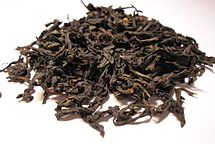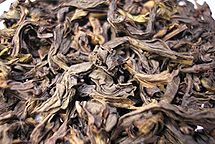User:LinearBicycle/Da Hong Pao
| Da Hong Pao | |
|---|---|

 | |
| Type | Oolong |
| Origin | Wuyi Mountains, Fujian Province, China |
| Quick description | Most famous of the Wuyi Rock Teas |
Da Hong Pao (Big Red Robe) is a Wuyi rock tea grown in the Wuyi Mountains of Fujian Province, China.[1] Da Hong Pao has unique orchid fragrance, long-lasting and tasted sweet in the end.[2] Dry Da Hong Pao has tightly knotted ropes shape, slightly twisted strips, and green and brown in color. After brewing, the tea is orange-yellow, bright and clear.[2] Compared to other tea, Da Hong Pao could brew for nine times and still has its flavor.[3]
Brew[edit]
The best way to brew Da Hong Pao is by using Purple Clay Teapot and 100℃ water temperature.[3] Purified water is considered the best choice to brew Da Hong Pao. After boiling, the water should be immediately used. Water boiled for a long time or long-term storage after boiling will influences the taste of the Da Hong Pao.[4] The third and fourth time brewing consider to be the best taste of this tea.[4]
Production[edit]
There are seven steps needed to make Da Hong Pao. 采摘-萎凋-凉青-做青-炒青-揉捻-烘培. [4]
- 采摘 (Picking):Da Hong Pao picked once a year, generally on May and June. The standard for fresh leaf picking are 1 bud with 2~3 leaves.[1]
- 萎凋(Withering): Spread the picked tea leaves evenly under sunshine, using sunlight and breeze to evaporate the water from fresh tea leaves.[4][5]
- 凉青(cooling) :After withering, move the tea leaves inside and cool down.[4]
- 做青(Making) : Using a big bamboo sieve and keep shaking, let the tea leaves rolling in it. That could conducive to the oxidation of polyphenols inside the tea leaves.[1] This step is the most crucial part to form the fragrance, taste and rhyme of Da Hong Pao.[1][4]And it is also the most complicated and time consuming step.[5]
- 炒青(Stir-fry): There are two types of stir-fry, hand stir-fry and mechanical stir-fry leaves. The pot temperature of hand stir-fry is between 140℃~160℃, people put on gloves and keep turning over the tea leaves with hands. The pot temperature of mechanical stir-fry is between 220℃~260℃, no hands needed. [4]
- 揉捻(Kneading): There are two types of Kneading, hand kneading and mechanical kneading. By kneading, rolling, twisting, the tea leaves will form a cord shape. [4]
- 烘培(Baking):This step including put the tea in a big basket and use different temperature to heat and dry the leaves which usually take hours. [4]
Health Benefits[edit]
Da Hong Pao contains caffeine, theophylline, tea polyphenols , and flavonoids.[2] For these reasons and others, a number of health benefits are claimed for the tea. Drinking Da Hong Pao could mitigate weariness and help blood circulation.[4] And it could also treat edema and water retention. Moreover, it helps decrease the bad effect of drinking and smoking. The elements contained in Da Hong Pao could reduce the alcohol and nicotine.[6] Furthermore, it has cosmetic effects. Drinking Drinking Da Hong Pao regularly is good for the skin[6] and helps lose weight. [4] Lastly, it helps relieving cough and reducing phlegm.[4]
Price and Value[edit]
The best Da Hong Pao are from mother Da Hong Pao tea tree. Mother Da Hong Pao tea tree have thousand years of history. There are only 6 mother trees remaining on the stiff cliff of Jiulongyu (Wuyi Mountains) which is considered as rare treasure.[1] Because of its scarcity and superior tea quality, it is known as the "King of Tea”.[6] In 2006, the Wuyi city government insured these mother trees with a value of one trillion RMB. In the same year, the Wuyi city government also decided to prohibit anyone from collecting tea from the mother Da Hong Pao tea tree.[7] (6) The last Dahongpao harvested and made from the mother tree has been collected in the Palace Museum in Beijing.[7] 20g of Da Hong Pao tea from one of the mother plants was sold for ¥208,000 in 2005, it is the highest auction record for Da Hong Pao.[4]

Da Hong Pao on the market now are from artificially bred through the asexually produced, which maintained the characteristics of the Da Hong Pao. [1][7] It is way more cheaper than Da Hong Pao from Mother Tea Tree. The price usually from ¥600~¥8,000 per pound depends heavily on its quality. [4]
Origin of the name[edit]
| LinearBicycle/Da Hong Pao | |||||||||||
|---|---|---|---|---|---|---|---|---|---|---|---|
| Traditional Chinese | 大紅袍 | ||||||||||
| Simplified Chinese | 大红袍 | ||||||||||
| Literal meaning | Big Red Robe | ||||||||||
| |||||||||||
There are many stories about the origin of Da Hong Pao’s name. The most famous one[6] is that a long time ago, there was a scholar who was very sick on his way to Beijing for an exam. A monk of Tianxin Temple found him and brewed a bowl of tea picked from Wuyi Mountain for the scholar. After drinking the tea, the scholar felt much better and energetic. Few days later, he won the first place in the exam. So he came back to the temple to thank the monk who saved him. Later, he also uses this tea to cure the emperor's illness. The emperor rewarded the scholar a red robe and asked the scholar to put the red robe on the tea tree. The red robe considered high honor at that time. The emperor also gave his orders: all officials passing through this place must put their red robes on tea trees to show the emperor’s gratitude for healing. After that, the tea tree were named Big Red Robe which in Chinese pronunciation is Da Hong Pao.
Trivia[edit]
- In the Qing dynasty, Da Hong Pao ranked first in the tea competition and won the title of "King of the tea." People were required to worship Da Hong Pao by using animals, flowers and fruits before pick the tea leaves every year.[4]
- During the Republic of China, the price of a pound of Da Hong Pao could buy 5000 pounds of rice or ten buffaloes.[4]
- After the People's Republic of China established, the procedure of making Da Hong Pao were especially strict. Every worker who picking the tea and making the tea went through political vetting. After checking and make sure the quality, the Da Hong Pao sent to Beijing and received by Mao Zedong.[4]
- When U.S. President Nixon visited China in 1972, Mao Zedong gifted him 200g Da Hong Pao which represented peace and friendship between China and United States.[4]
See also[edit]
References[edit]
- ^ a b c d e f Zhao, Yuxiang (2015). 北京联合出版公司. BeiJing: 茶叶鉴赏购买指南:2015~2016全新升级版. ISBN 9787550260139.
- ^ a b c Xu, Xinya (2014). 识茶·泡茶·品茶. BeiJing: Chinese Overseas Publishing House. ISBN 9787511342249.
- ^ a b Chen, Long (2013). 中国茶艺茶道轻松入门. BeiJing: Publishing House of Electronics Industry. ISBN 9787121202988.
- ^ a b c d e f g h i j k l m n o p q r Lin, Zhi (2011). 画说大红袍. Beijing: China Publishing Group. ISBN 9787510034978.
- ^ a b Chen, Dehua (2015). 《武夷岩茶(大红袍)研究》. China: Science and technology of China press. ISBN 9787504668585.
- ^ a b c d Luo, Jun (2016). 中国茶典藏: 220种标准茶样品鉴与购买完全宝典. Beijing: China Textile & Apparel Press. pp. chapter 2. ISBN 9787518027460.
- ^ a b c Shen, Jia (2012). 我爱喝乌龙茶. BeiJing: Publishing House of Electronics Industry. ISBN 9787121178443.
Further reading[edit]
- Sutcliffe, Theodora (26 April 2016). "The drink that costs more than gold". bbc.com. Retrieved April 27, 2016.
External links[edit]
- Chinese Famous Tea – Dahongpao at teavivre.com
 | This is a user sandbox of LinearBicycle. You can use it for testing or practicing edits. This is not the sandbox where you should draft your assigned article for a dashboard.wikiedu.org course. To find the right sandbox for your assignment, visit your Dashboard course page and follow the Sandbox Draft link for your assigned article in the My Articles section. |
